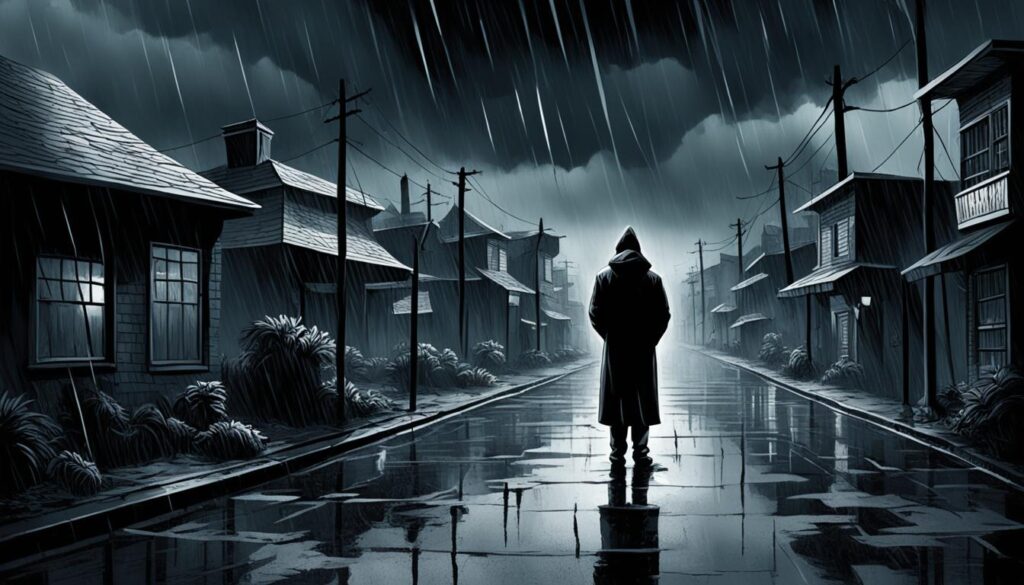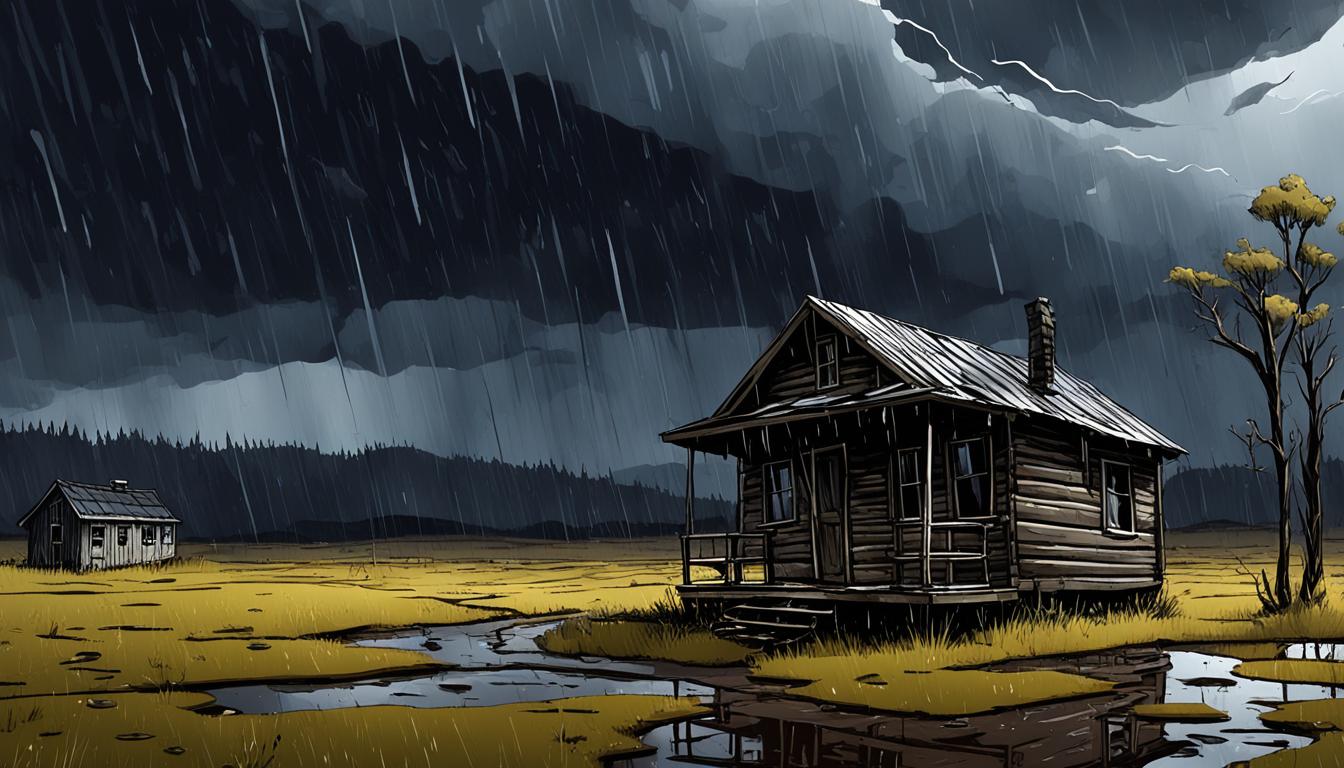If you’re a fan of horror literature, chances are you’ve heard of Stephen King – master of the genre and creator of spine-chilling classics. One of his most gripping short stories, “Rainy Season,” takes readers on a terrifying journey through a torrential downpour in a small town. The story masterfully weaves together suspense, vivid imagery, and an eerie atmosphere that will leave you on the edge of your seat.
Join us as we unravel the haunting tale of “Rainy Season” and explore how Stephen King’s writing style sets him apart as a masterful storyteller in the horror genre.
Key Takeaways:
- Stephen King is a well-known master of horror literature
- “Rainy Season” is a gripping and terrifying short story
- King’s distinctive writing style creates an eerie atmosphere and builds suspense
- The story explores themes of fear, isolation, and the supernatural
- “Rainy Season” showcases King’s talents as a master storyteller
Introduction to “Rainy Season”
One of the most prominent horror writers of our time, Stephen King has amassed a devoted following due to his mastery of the genre. Among his many written works is the short story “Rainy Season,” which continues to captivate readers with its unsettling narrative. As we begin our exploration of this spine-chilling tale, we will take a brief moment to introduce “Rainy Season” and discuss Stephen King’s reputation in the horror genre.
From his notable novels such as “The Shining” and “It” to his short stories like “The Mist” and “Night Shift,” Stephen King has become synonymous with horror. His ability to create vivid imagery and atmospheric settings sets his work apart from others in the genre. “Rainy Season” is no exception, as it showcases King’s unmistakable style and unsettling approach to storytelling.
As we continue to explore the twisted world of “Rainy Season,” we will uncover the many ways in which Stephen King’s writing has captured the hearts and minds of horror enthusiasts around the world. Get ready to be transported to a world of fear and terror as we dive deeper into this thrilling short story.
Plot Summary of “Rainy Season”
The story of “Rainy Season” begins with a couple, Hugh and Dierdre, who are traveling to a new home in Willow, Maine. As they arrive, they encounter a strange local couple, Ethel and Toad, who warn them about the hazards of the upcoming rainy season. Despite the warning, Hugh and Dierdre dismiss the couple’s concerns and continue with their plans to stay in the town.
As the rain begins to pour down, the couple soon realizes that something sinister is happening in the town. Strange, frog-like creatures begin to emerge from the basement of their new home, wreaking havoc and threatening their safety. Hugh and Dierdre must battle to survive the relentless rain and the supernatural forces lurking within the town.
Stephen King’s “Rainy Season” is a gripping and terrifying tale of horror that will leave readers on the edge of their seats.
“The water running down the windows grew louder until it became a dull, continuous roar. Beyond it, on the lawn, the stones rattled and jumped in time to the battering of the rain.” – Stephen King, Rainy Season
Analysis of Stephen King’s Writing Style
Stephen King is widely regarded as a master of horror storytelling, with a writing style that expertly builds suspense and terrorizes readers. In “Rainy Season,” his use of vivid imagery transports readers to the eerie small town and the relentless downpour that sets the ominous tone of the story.
King’s use of character development is also noteworthy in “Rainy Season,” drawing readers into the lives of the main characters and creating an emotional investment in their fate. The gradual unfolding of their individual fears adds to the overall tension of the story, leaving readers on the edge of their seats.
One of King’s greatest strengths is his ability to weave suspense throughout his stories, creating a thrilling and unpredictable ride. The gradual escalation of tension in “Rainy Season” builds to a terrifying climax that stays with readers long after the story ends.
“Stephen King’s writing style is a powerful force in the horror genre, and ‘Rainy Season’ is a prime example of his mastery of storytelling. His use of suspense, vivid imagery, and character development creates a gripping tale that keeps readers hooked until the very end.”
Themes in “Rainy Season”
Stephen King’s “Rainy Season” explores several underlying themes that contribute to the overall message of the story. One of the predominant themes is fear, as the main characters are caught in an isolated village during an intense storm, facing unknown terrors lurking in the darkness.
Isolation is another key theme, as the couple finds themselves cut off from the rest of the world, with no escape from the relentless rain, and forced to confront their deepest fears.
The supernatural also plays a significant role in the story, with eerie occurrences suggesting the existence of otherworldly forces at work. This theme is evident throughout the narrative, culminating in a terrifying climax that leaves the reader on the edge of their seat.

“‘Rainy season,’ he thought, and felt a little shiver trace its way up his spine. No. Not that. Nothing like that, as a matter of fact.” – Stephen King, “Rainy Season”
These thematic elements contribute to the overall effect of the story, showcasing Stephen King’s mastery in the horror genre. The themes of fear, isolation, and the supernatural make “Rainy Season” a haunting and unforgettable read, leaving a lasting impact on all those who dare to brave its chilling pages.
Symbolism in “Rainy Season”
Stephen King’s “Rainy Season” is a masterful use of symbolism to enhance the eerie atmosphere of the story. The rain itself serves as a metaphor for more ominous events to come. The repeated description of the rain as “acidic” and “tasting of metal” hints at the danger lurking beneath the surface.
The setting is also rich in symbolism, with the isolated town of Willow serving as a microcosm for the horrors inside. The town is cut off from the outside world and surrounded by a dense forest, accentuating the feeling of isolation and danger.
The scarecrow, a staple in horror imagery, also serves a symbolic role. It represents the malevolent spirit haunting the town, taking on different forms to suit its needs. The scarecrow’s transformation into a human-like figure mirrors the transformation of the town’s residents into grotesque creatures.
Overall, Stephen King’s use of symbolism in “Rainy Season” adds layers of meaning to an already terrifying story, inviting readers to delve deeper into the dark and twisted world of his imagination.
Reception and Impact of “Rainy Season”
Since its publication in 1989, “Rainy Season” has received critical acclaim by both readers and critics. Known for his exceptional storytelling and ability to evoke a sense of dread, Stephen King has created a gripping short story that has stood the test of time.
The horror genre has been forever changed by the influence of Stephen King and his works. “Rainy Season” has had a lasting impact on the genre, inspiring other horror writers to explore similar themes and motifs. The eerie atmosphere and rich symbolism in this short story have left a lasting impression on fans of horror fiction.
“[King’s] ability to create suspense is especially impressive in the short form… ‘Rainy Season’ is expertly crafted, loaded with tension. It’s a quick read, but you’ll be thinking about it long after the last page is turned.” – Brian K. Lingard, The San Francisco Chronicle
As King’s body of work continues to grow, it is evident that “Rainy Season” remains a standout piece of horror fiction. Its impact on the genre and its enduring appeal among readers make it a crucial addition to any horror enthusiast’s library.
The Impact on Stephen King’s Body of Work
“Rainy Season” is reflective of Stephen King’s larger body of work in the horror genre. The short story showcases his signature writing style and themes, providing an intimate look at his approach to storytelling. As one of his most beloved pieces of short fiction, “Rainy Season” has informed and shaped the trajectory of King’s writing career.
The lasting impact of “Rainy Season” can be seen in the recurring motifs and symbols found throughout King’s other works. Fans of King will recognize the rain, storms, and other natural elements that frequently appear in his novels and stories. The success of “Rainy Season” has undoubtedly influenced King’s future writing and the horror genre as a whole.
Cinematic Adaptation of “Rainy Season”
Like many of Stephen King’s works, “Rainy Season” has been adapted to the screen. The short story was adapted into a short film in 1993, directed by Chris Walas and starring John Toles-Bey and Gretchen Becker.
Despite the challenges of adapting a short story into a visual medium, the film successfully captures the eerie atmosphere and suspenseful plot of “Rainy Season.”
The film adaptation has received critical acclaim, with fans of Stephen King’s work appreciating how well the story translates onto the screen.
Stephen King’s Other Notable Works
Beyond “Rainy Season,” Stephen King has a vast repertoire of spine-tingling horror novels that have captured readers’ imaginations for decades. One of his most famous works is “The Shining,” a chilling story of a family’s descent into madness after a winter spent in a haunted hotel. Another must-read is “It,” a novel that delves into the dark history of a town plagued by a malevolent being that takes the form of a sinister clown.
For those seeking stories with more supernatural elements, “Carrie” and “Salem’s Lot” offer a unique blend of horror and the paranormal. “Pet Sematary” explores the devastating consequences of death and grief, while “The Stand” presents an apocalyptic vision of a world in chaos.
“Stephen King is a master of horror, and each of his works offers a unique perspective on the genre. From haunted hotels to malevolent creatures, his stories are sure to chill you to the bone.”
Regardless of your personal taste, Stephen King’s other notable works are not to be missed for any horror fan looking to experience the full scope of his imagination.
Conclusion
In conclusion, “Rainy Season” is a haunting and unforgettable short story that showcases Stephen King’s exceptional talent for horror storytelling. The relentless rain, vivid imagery, and well-crafted characters contribute to the story’s overall impact on readers.
The use of symbolism and exploration of underlying themes elevates the narrative to a deeper level and provides readers with much to contemplate even after the story ends. The critical reception and lasting impact of “Rainy Season” are a testament to its enduring power in the horror genre and to King’s influence as a master storyteller.
For those looking to further explore King’s chilling imagination, his notable works in the horror genre, including “The Shining,” “Carrie,” and “IT,” are highly recommended. Each offers a unique and unsettling experience for readers.
In conclusion, “Rainy Season” is a must-read for any horror enthusiast seeking a gripping and unnerving tale. Get ready to be swept away into the terrifying world of Stephen King’s storytelling.



